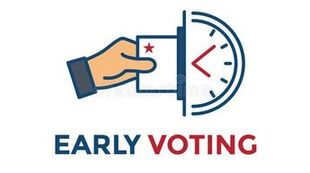 A fundamental part of the Greater Bloomington Chamber of Commerce’s mission is our focus on advocacy and public policy. Chamber members are deeply committed to making our community a better place to live, work, and have fun. We understand that businesses and local government must work closely together to achieve the quality of life that our residents deserve here. Along those lines, the Chamber takes local elections very seriously, and our goal with any election is to maximize voter participation. This year, we have three candidates on the ballot for Mayor of Bloomington – an elected office that has a significant impact on Bloomington businesses and residents. It is my opinion that local government has more day-to-day impact on a person than any other level of government. It is imperative that we elect local leaders who reflect the needs and values of the community. Further, it is critical that as many people as possible participate in the decision to elect our leaders. If you’re an eligible voter, we need you to vote! This may come as a surprise to many readers but mark my words: in less than two weeks, we will know who the next mayor of Bloomington is. To be exact, we will know on May 2nd because that is primary election day. You will not have to wait until the general election in November because the decision on who will lead our city for the next four years will be made in the Democratic primary on Tuesday, May 2nd. And, like it or not, the electoral math tends to favor Democrats in Bloomington. It has been that way for several decades, and that trend is not expected to change this year. As a former elected office holder myself, I knew that if I could win the primary, I was essentially guaranteed a win in the general election. In fact, there are often no Republican opponents on the other side of the ballot, which makes the general election completely irrelevant for many local offices. Given the electoral realities of Bloomington, we should all be interested in the anticipated voter turnout numbers for the upcoming primary election on May 2. The only way to meaningfully project these numbers is to examine the data from the most recent competitive primary election for city offices, which was 8 years ago in 2015. There were also three Democratic candidates running for mayor of Bloomington in 2015. When examining the voter turnout numbers in the 2015 primary election, it is astounding that in a city of over 85,000 people, only 7,027 people cast a ballot. In other words, about 8% of the total population of Bloomington had an interest in deciding who would lead our city for four years. Unfortunately, 8% is about the same turnout that we expect again this year. What is even more astonishing is that Mayor John Hamilton – the winner of the 2015 Democratic primary election – received a total of just 3,790 votes. That translates to about 4% of the Bloomington population that decided the winner. It is important to note that although all the candidates for mayor this year are running as Democrats, you do not need to be a Democrat to vote for one of these individuals. If you are an independent or a Republican, you can still vote. Contrary to popular belief, you do not need to register with the Democratic Party to vote in the Democratic primary. You can simply walk into your polling place and tell the election workers that you want to vote for mayor. Regardless of your political beliefs, do not disenfranchise yourself in this election. Who we elect to lead our city for the next four years is far more important than staying silent in this election. Use the power of your vote to make your voice heard on May 2. Based on the numbers above, every single vote will assuredly count this year. - Eric Spoonmore, President/CEO of the Greater Bloomington Chamber of Commerce
0 Comments
 On April 24th, the Indiana Senate approved House amendment changes for SB 7: Physician Noncompete Agreements. If signed into law by Governor Holcomb, this law would allow physicians who have been terminated or fired from their positions to seek employment at hospitals outside of their previous network. This bill has been considered a success by lawmakers who believe these types of agreements decrease competition and increase consumer costs. Other lawmakers say that a recent amendment change to this bill, which only applies this ban to primary care physicians, will have negative effects on specialists who want the same protections. There are two more amendments that are up for Senate approval, and lawmakers have until the end of the week to approve changes (according to legislative session deadlines). To learn more about SB 7 and track changes, click HERE!  I live in a politically active community. The mayoral race in Bloomington has had a lot of interest. The Monday night Chamber Mayoral Forum on Business, my employer, was one of many such events hosted by community/civic groups. We are like many Hoosier communities with a 1 party system. The primary on May 2nd essentially elects the winner. I’ve lived in other states with similar circumstances. It’s why I’ve voted in both parties’ primary elections. In Indiana, you don’t even have to specify your party affiliation when you register. Show up to the polls and pull the lever. Every vote counts, but it matters more when fewer people go to the polls. We have seen shifts in many city councils’ makeup by organized minorities focused on issues such as growth. Here in Bloomington, we will be lucky to trot out 8,000 voters in a town of 80 odd thousand. We are fortunate to have 3 distinct options available for mayor. There are choices to be made, and fallout from said choice. I hear people bemoan the 1 party system in our local government. In a perfect environment, we would have a strong 2 party system here in Bloomington and the entire State of Indiana. Where I push back is that we do not have a strong party apparatus on any level of government. It remains candidate driven. Individuals are welcome to run for office and vote how they feel when they become elected officials. I attend city council meetings weekly where I see the divisions on full display. “Growth” is a funny local issue unto itself. It does not have a party identification. For different reasons, both sides of the political spectrum can be against it and for it. I tease my Carmel resident colleagues about the top-down government-laden approach to their planned growth. I can poke fun at the method but not the results. |
Categories
Categories
All
Archives
Archives
May 2024
|
|
Copyright The Greater Bloomington Chamber of Commerce. All Rights Reserved.

 RSS Feed
RSS Feed
